George White as Nutt, George Nutt alias White ...


Above: The database image with verso at the Queen Victoria Museum and Art Gallery: note that the verso is inscribed with the conventional date of Nevin's photographic registration (1874), the alias, and the ship on which Nutt was originally transported before 1853, but the transcription which appears on many other versos of convicts' cartes - "Taken at Port Arthur" - is absent. Nevin may have photographed Nutt at Port Arthur between 23rd February and 8th May 1874; the former date being another sentence for Nutt for breaking the cell while trying to escape, the latter being one of the dates on which Nevin attended Port Arthur on police business. He was absent from Hobart when his father-in-law Captain James Day registered the birth of Thomas James Nevin jnr in May 1874.
The transcriber of the notes on the verso of the carte - probably at Beattie's Museum in Hobart in the early 1910s - has collated the prisoner's record with the photograph, and assumed the date "1874" was the date of Nevin's photographic capture. As prison official A. H. Boyd was gone from Port Arthur by December 1873, his attribution is doubly impossible, being neither there nor being a photographer, amateur, official or otherwise. There was NO photographer in Tasmania by that name, nor are there any extant photographs bearing that name.
Thomas Nevin would have taken another photograph of Nutt in any event as a re-offender in 1875 when Nutt was arrested for absconding, and this is the image.

Webshot AOT of Thomas Nevin's carte of George Nutt alias White 1875
POLICE RECORDS
The carte-de-visite of convict George Nutt alias White, which is also online at the Archives Office of Tasmania (the AOT has reversed the alias per original Separate Model Prison records of 1870-1), was taken by Thomas Nevin soon after Nutt was arrested on September 3rd, 1875. Nutt escaped while under sentence on 24th August, 1875 from the Port Arthur settlement, and was considered desperate enough that a reward was offered which was posted in the weekly police gazettes (Tasmania Reports on Crime for Police Information 1875) during the fortnight of the convict's freedom.
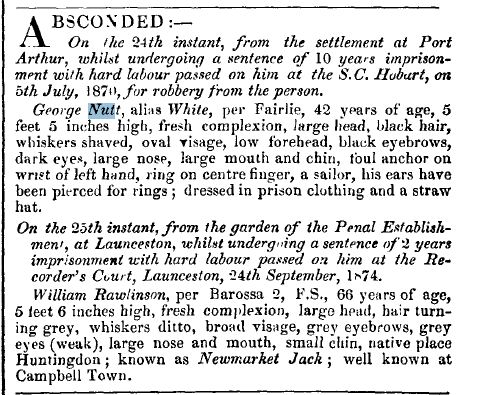
Above: The notice in the gazette on 27th August, 1875.
Some details about his height were amended in the following week's description for police information:

The notice appeared again on the eve of Nutt's capture:
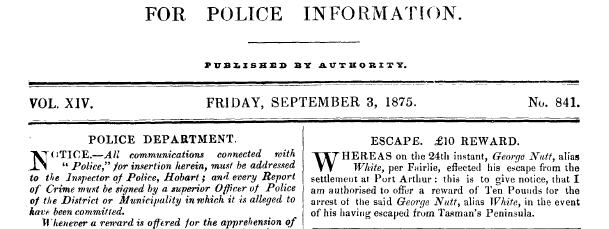
And the notice of his arrest appeared in the same issue, September 3rd, 1875.

Sources: Tasmania Reports on Crime for Police Information 1875.
James Barnard, Govt printer.
THE FAIRLIE 1852
Thomas Nevin would have been able to recognize and describe George Nutt from their common experience as passengers travelling to Australia on board the Fairlie, which arrived in Hobart on July 3rd, 1852. Thomas Nevin was still a child in 1852, the ten year old son of a guard, formerly of the Royals Scots, John Nevin, accompanying his mother Mary and three siblings, William John (Jack) , Rebecca and Mary Ann. George Nutt was a Parkhurst boy, a transported exile from the prison of the Isle of Wight. He would have been about 18 years old in 1852, if he was 42 years old when he fled the Port Arthur prison in 1875.
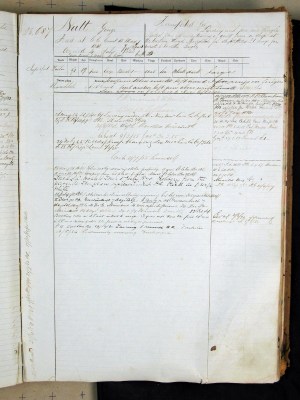
Above: Nutt's convict record at AOT
Ref: CON33-1-107_00197_L
Unlike many of these transportation records, this one contains some information of Nutt's work record and serial criminal offenses upto his discharge in 1884.
COPIES and DUPLICATES and ALIASES
The Archives Office of Tasmania & the Queen Victoria Museum and Art Gallery copies of this prisoner's vignette both bear the number "1" on the mount, recto. An ink stain of a square stamp partially covering the convict's face is evident on the AOT copy.

AOT: PH30/1/3222
Caption by AOT: Possibly George White alias Nutt convict transported per Fairlie 1852
Photo taken at Port Arthur by Thomas Nevin 1874
Archives Office of Tasmania photographic database:
PH30/1/3222
Title: George White
Subject: convicts, people, portraits
Locality: not identified
Date: 1874
Archives Office of Tasmania Convicts' names database:
Database number:81329 Name: White, George
Arrived: 03 Jul 1852 Fairlie
Departed: 11 Mar 1852 Plymouth
Transported as George Nutt
The AOT has used Nutt's transportation record with details of his incarceration in 1870-71 at the Separate Model Prison Port Arthur where he was documented George White as Nutt -
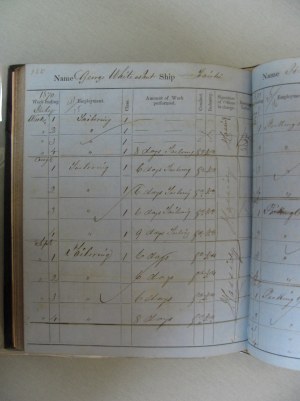
White as Nutt in Separate Prison July 1870
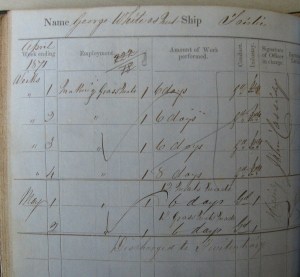
White as Nutt Separate Prison April 1871
George White as Nutt,
Separate Model Prison 1870-1
Mitchell Library, SLNSW
Photos © KLW NFC 2009 ARR
The police, however, documented his escape as Nutt alias White. According to information detailing the Parkhurst Boys at Convict Central, a 13 year old boy called George Nutt was convicted of larceny on 15th May 1848, sentenced for 7yrs and transported on the Fairlie departing Plymouth on March 2nd, 1852, arriving in Tasmania on July 3rd, 1852. The transportation record (above) confirms these details, although his age by 1852 was given as 19 yrs. He was listed as a tailor or shoemaker. George Nutt would have been born ca 1834 if aged 13 at the time of conviction in 1848, and would have been around 42 in late 1875. The photograph by Nevin shows a man of that age.
COPYING
Nevin took the one surviving image of Nutt as a police photograph at the Hobart Gaol where Nutt was incarcerated after arrest in 1875. The photograph was printed from the glass negative as a standard police identification carte-de-visite in an oval mount, typical for police mugshots of the period, and pasted to Nutt's criminal record sheet. The number "1" on the mount may have been written by the same person in the 1980s at the QVMAG when so many of these prisoner cdvs were copied and dispersed to the TMAG and Archives Office in Hobart. It might be Nevin's numbering, on the other hand, or one used by the police, and there would have existed at least five more duplicates circulated to police, but more likely it has been numbered by museum archivists on accession or for copying. Another indication on this carte that it was the first photograph in an album copied as a series at the QVM in 1958 is the impress left by the square QVM stamp across George Nutt's left cheek and collar from the verso of the second carte in the series in 1958 which was placed on top of it, that of convict carte No.2, Nevin's vignette of Wm Yeomans.
For this reason, the square stamp ink is visible in the AOT image, but not in the QVMAG image, although identical in all other respects, which points to multiple copies made by the QVMAG archivist (in Launceston) for circulation to the AOT office (in Hobart). The original from which 20th century copies were made may be the one held at the QVMAG but not necessarily the only duplicate which was first made by Nevin from his glass negative and used in criminal registers hedl at the Hobart Gaol and Municipal Police Office, Hobart Town Hall.
For example, there are three extant copies of the photograph taken once and once only by Thomas Nevin of prisoner William Yeomans: one at the QVMAG, one at the AOT, both numbered "2" on the front, and a third which is held at the National Library of Australia with no numbering on the front, rather, it is numbered "57" on the verso, testifying to further copying from a single original glass negative either by Nevin for the prison authorities' immediate use, or by later archivists again. The NLA copy of the Yeomans carte is an archival estray donated there by Dr Neil Gunson in 1964 and accessioned in Nevin's name. But under the influence of Elspeth Wishart and her former colleague at the TMAG, Julia Clark, the NLA has recently been co-opted to apply the misattribution to Boyd of their 84 "convict portraits", further effectively suppressing Nevin's former sole attribution, for no reason other than to attempt to mask their collective foolishness in believing Chris Long's idle speculations (1984,1995). Their doggedness is tantamount to professional fraud.
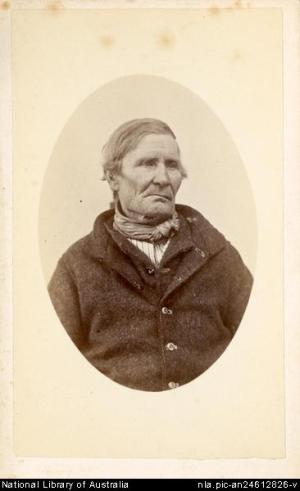
NLA Catalogue notes:
Part of collection: Convict portraits, Port Arthur, 1874.; Gunson Collection file 203/7/54.; Title from inscription on reverse.; Inscription: "No 57"--On reverse.; Also available in an electronic version via the Internet at: https://nla.gov.au/nla.pic-an24612826.
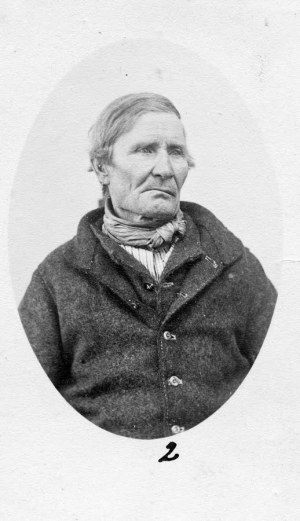
Photograph of convict William Yeomans by Nevin at the QVMAG and AOT.
The recto on Yeomans' carte is numbered "2' and was most likely placed on top of the front of Nutt's carte when the QVMAG archivist was in the process of copying them in 1958. The catalogue number for the job in 1958 was 1958:78:22, accompanied by the QVM stamp with more numbers.
The original transcription of the convict's name and ship and the date 1874 was added much earlier, probably ca. 1900-1927, given the calligraphic style. The most recent inscriptions by archivists date from 1985; e.g. QVM1985:P69, and are in a childish hand. Again, there is NO statement on this verso that the photograph was taken at Port Arthur, the probable explanation being that these first few cartes were transcribed verso and copied by one person, and the remainder at a later date by another.
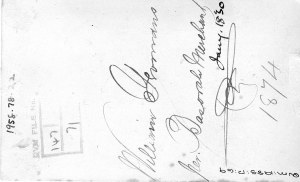
MISATTRIBUTION: QVMAG, TMAG, DAAO
Cataloguists, librarians, archivists, students, photo historians and others in public service have made a real mess of storing and recording the accession history, numbering, and data collation on these Tasmanian prisoners' identification photos: obliteration, reinvention, fads, guesses, fashions, and personal agendas have managed to obliterate valuable data and thus the traces of facts from their past.
George Nutt's prisoner identification photograph is one example. It was one of more than 70 exhibited at the Queen Victoria and Museum Gallery in 1977, with correct attribution to Thomas Nevin from the Beattie collection. But by 1984 a researcher on a very tiny budget, Chris Long, who had the job of putting together an A-Z directory of Tasmanian photographers (published in 1995) for the Tasmanian Museum and Art Gallery in Hobart, indulged a speculation that photographic supplies supposedly sent to Port Arthur in August 1873 were used personally by the Civil Commandant to photograph the prison's inmates (letter to Nevin descendants 1984, letter to the authors Davies and Stanbury, The Mechanical Eye 1985). The Civil Commandant from 1871 to December 1873 was A.H. Boyd, with no reputation in his lifetime as a photographer, no history of training or skills, and no extant works. No police or official documentation associates his name with prisoner photographic records and there has never surfaced any evidence to support this "idea" or "belief", but because of the self-referential world of art history, photo historians such as Ennis, Crombie and Reeder have credited Chris Long and used his "idea" as a possible attribution, extending to the present as a "likely" attribution by the sycophantic Clark. This simple fallacy of judgment by Long and his unquestioning cohort has misled commentators, and more significantly, librarians and museum cataloguists into suppressing Nevin's attribution, foregrounding the name A.H. Boyd, ignoring the circumstances and contexts of police practices, and labelling the ID photos as "portraits" - aesthetic objects, in other words. Chris Long has since regretted the confusion he caused (acknowledged 2005, email to these weblogs), blaming difficulties with his editor Gillian Winter (1995) and unsubstantiated rumours spread by Boyd's descendants, but the misattribution in public institutions is still evident in their catalogues. George White aka Nutt's carte has gone from this record:
Archives Office of Tasmania (and current at June 2010)
Carte no. 1
PH30/1/3222
Title: George White
Subject: convicts, people, portraits Locality: not identified
Date: 1874 Possibly George White (alias Nutt) convict transported per Fairlie.
Photo taken at Port Arthur by Thomas Nevin
and this original record at the QVMAG (prior to 1985)
Nevin, Thomas J. 1874
QVMAG carte no. 1
George White, alias Nutt
Fairlie
to this now at the QVMAG from 1985 (until 2009) when Elspeth Wishart re-catalogued all these convict photographs for an Exhibition purely because of Long's idle speculation:
QVMAG from 1985-2009
Registration Number: QVM: 1985:P :0070
Type: carte de visite
Producer/Photographer: Boyd, Adolarious Humphrey
Content: Portrait of George White alias Nutt at Port Arthur, Tasmania, 1874.
Notice that the data about ship, date of transportation, and former catalogue numbers are all gone, and the aesthetic term "portrait" has subsumed the documentary facts. When asked why the QVMAG had obliterated Nevin's attribution, which was correctly assigned in 1977 by the same institution, the QVMAG, their reply was simply - "because of comments made by Chris Long, " without so much as a backwards glance at their own curatorial history (letter from Community History Technical Officer - see this article: The QVMAG, Chris Long and A. H. Boyd.)
AS AT JUNE 2010
The QVMAG has now brought online most (but not all) of their database holdings of these convict photographs, with a revised catalogue entry for Nutt (below). The first cataloguing of these photographs by the QVM was in 1958, evidenced by the stamp on versos, and the second database dates from 1985. A new database collation needs to be performed, going back to the original cartes and glass negatives to include the criminal records sheets with prisoners' cartes attached, mentioned by Nevin's curator for the 1977 QVMAG exhibition, John McPhee, in correspondence with the Specialist Librarian G.T. Stilwell.
Purely because of one idle comment by Chris Long that forced an association with the Commandant A.H. Boyd as the photographer of these "convict portraits" (i.e. police mugshots), the former employee at the QVMAG and now an historian at the Tasmanian Museum and Art Gallery, Elspeth Wishart, has pushed onto the public the Boyd misattribution, both at the TMAG and per this entry online at the QVMAG website (webshot below). A.H. Boyd has no entry in the mammoth publication, Dictionary of Australian Artists to 1870 (ed. Joan Kerr 1992), while Nevin does, complete with attribution as the photographer of these convict images (p.568), yet Boyd has an entry as THE photographer of these prisoner cartes in the DAA online version, probably because Wishart and Clark were actively involved as contributors who authored the fatuously illogical comment -"not surprising given his job as penal officer".
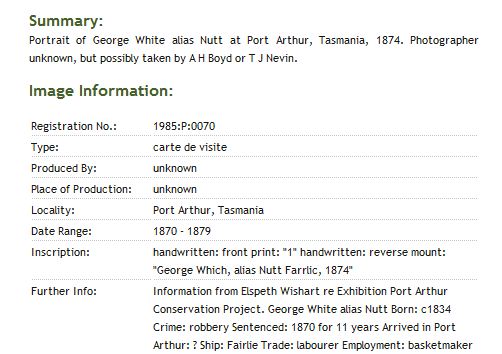
The entire misattribution problem has its genesis in a belief that a single sentence in an unpublished children's fictional tale about a holiday at Port Arthur, written in 1930 by a niece of A.H. Boyd, E.M. Hall, called "The Young Explorer" (SLTAS) which does NOT mention Boyd by name NOR does it refer to the photographing of prisoners at the Port Arthur prison, can be taken as FACT. Elspeth Wishart and her former colleague at the TMAG, Julia Clark, are determined to promulgate the A.H. Boyd misattribution with appeals to impressionable staff at the National Library of Australia and other public institutions, not to mention the editors of academic journals (JACHS 2010) purely to mask their own gullibility in placing all their faith in Chris Long's assumption that a paragraph from children's fiction can function as historical fact.
AS AT JUNE 2012
No one knows anything!
For further discussion on this issue see these articles:
- Margaret Glover and the fabrication of photohistory
- Improprieties: A. H. Boyd and the Parasitic Attribution
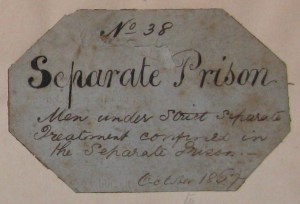
Separate Prison records, Mitchell Library, SLNSW
Photos © KLW NFC 2009 ARR
